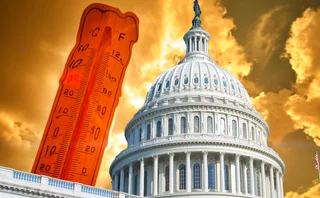
Institutional investment product of the year: Nomura

Buy-side Awards 2016
Have insurers and pension funds lost faith in experts? In a year that has seen dire returns for many hedge funds – including quant funds relying heavily on physics and computer science PhDs – the appeal of a product that offers cheap exposure to similar sources of return is compelling.
Nomura’s Cross Asset Momentum Ucits fund profits from time-series momentum, the tendency for an asset with good recent past performance to continue to do well.
While big commodity trading advisers (CTAs) charge a bit less than 2% management fee and 20% of any profits for trend-following (perhaps 1-and-10 for institutional investors), the Ucits fund charges between 0.5% and 1.2% with zero performance fee.
“As a research person, I would love to tell you it’s all intellectual content that drives performance, but it isn’t. Trend-following is nothing terribly new: it’s been going on for 50 years if you’re American, maybe 300 if you’re Japanese,” says Anthony Morris, head of quantitative strategies for Nomura’s research arm.
He is sceptical of the idea that more PhD researchers leads to higher risk-adjusted returns for investors. “Trend-followers add as a class essentially zero to negative alpha compared to vanilla trend-following. The analytical mistake people make is they measure the alpha of quant funds against the S&P 500, and that’s overly flattering,” he says.
Trend-followers add as a class essentially zero to negative alpha compared to vanilla trend-following. The analytical mistake people make is they measure the alpha of quant funds against the S&P 500, and that’s overly flattering
Anthony Morris, Nomura
He cites a study by Hans-Olov Bornemann, portfolio manager for SEB Investment Management, that found the correlation between the Sharpe ratio of CTAs and their number of researchers was 0.09, based on a study of 23 big CTAs. According to Bornemann, excluding the two funds with the highest and lowest Sharpes yielded a correlation of –0.31: that is, the more researchers the hedge fund had, the worse its returns.
Nomura’s averred distinction from quant funds is its sell-side infrastructure, which has allowed it to reduce operational costs and to trade interest rate swaps efficiently before other CTAs started investigating swaps as a source of returns.
“What really makes the difference is logistics. It really has to do with operations. If you notice, the big quant houses have relatively large operations teams,” says Morris. “So the value proposition of doing this on a sell-side platform is it’s essentially almost zero marginal cost.”
While other fund managers would have to hedge additional unwanted risk exposures from index positions, instantaneously and at extra cost, Nomura’s net hedges pale in relation to the institution’s total risk exposure. “A trend-following index position generates additional deltas but it’s pretty much a rounding error compared to the total deal flow,” says Morris.
Infrastructure
The team says CTAs are starting to trade interest rate swaps in a way Nomura began to do years ago. Launching a swap trading operation, which entails building pricing models and sourcing market data, has been the result of detailed research on behalf of buy-side firms such as Aspect Capital and Cantab Capital Partners.
“Traditional CTAs have an operations and a trading infrastructure that allows them to trade futures, which may be why they have been reluctant over the years to implement trend-following in interest rate markets. As a traditional CTA, it would be fairly atypical to talk to a sell-side provider of a momentum commodity index, to manage the swap with collateral, make due diligence on the index and satisfy yourself that it is Ucits-compliant,” says Jean-Philippe Royer, chief executive officer of Nomura Alternative Investment Management.
A broker-dealer, typically Nomura’s trading desk, sells performance swaps on momentum strategy indexes to its Cross Asset Momentum Ucits fund. There are four different types of swap, one for each global asset class: equities, rates, foreign exchange and commodities. The fund would separately buy high-quality bonds to use as collateral.
Trading performance swaps via Nomura reduces costs in what would otherwise be a costly exposure to momentum. It also allows the fund to track commodities, direct exposure to which is banned by Ucits rules and which few Ucits fund managers have made a success of.
Expense versus value
“Is it more expensive to trade swaps than government bond futures? For sure, but the question is not what the transaction costs. The appropriate question is, assuming I net all those transaction costs out, what is the best value-creation mechanism?” says Morris.
The fund does not trade government bond futures, which the team says have been distorted by mass central bank intervention. “The government bond curve does not behave like it used to and the interest rate swap curve is more similar to what a classical interest rate curve should look like,” says Morris.
“If you want to trade GBP or JPY government bond futures, you just have the 10-year point. You can’t do one, three, 20 years, and that’s like tying your hand behind your back. We didn’t want those restrictions,” he says.
He thinks now is the opportune moment to buy momentum funds, particularly as equity and bond prices have boomed since the financial crisis, and pension funds may face a lack of positive correlations between the two. Were equities to tumble, there would be little room for bond prices to get much higher.
“If you’re looking for a new bond, so to speak, in an environment of low yields, you have to look beyond the bond market, because the bond market has effectively become a short vol carry trade,” says Morris.
Trend-following strategies can benefit from extreme asset price moves up and down. “The beautiful thing about rules-based strategies is that they avoid bias of narrative fallacy. Too many people both on the buy side and the sell side have a macro narrative that they think explains the world.” he says.
Image: Shutterstock
Only users who have a paid subscription or are part of a corporate subscription are able to print or copy content.
To access these options, along with all other subscription benefits, please contact info@risk.net or view our subscription options here: http://subscriptions.risk.net/subscribe
You are currently unable to print this content. Please contact info@risk.net to find out more.
You are currently unable to copy this content. Please contact info@risk.net to find out more.
Copyright Infopro Digital Limited. All rights reserved.
As outlined in our terms and conditions, https://www.infopro-digital.com/terms-and-conditions/subscriptions/ (point 2.4), printing is limited to a single copy.
If you would like to purchase additional rights please email info@risk.net
Copyright Infopro Digital Limited. All rights reserved.
You may share this content using our article tools. As outlined in our terms and conditions, https://www.infopro-digital.com/terms-and-conditions/subscriptions/ (clause 2.4), an Authorised User may only make one copy of the materials for their own personal use. You must also comply with the restrictions in clause 2.5.
If you would like to purchase additional rights please email info@risk.net
More on Asset management
Execs can game sentiment engines, but can they fool LLMs?
Quants are firing up large language models to cut through corporate blather
Pension schemes prep facilities to ‘repo’ fund units
Schroders, State Street and Cardano plan new way to shore up pension portfolios against repeat of 2022 gilt crisis
Fears of runaway risk on offshore reinsurance
Life insurers catch the eye of UK regulator for pension buyout financing trick
Hot topic: SEC climate disclosure rule divides industry
Proposal likely to flounder on First Amendment concerns, lawyers believe
‘Brace, brace’: quants say soft landing is unlikely
Investors should prepare for sticky inflation and volatile asset prices as central banks grapple with turning rates cycle
Trend following struggles to return to vogue
Macro outlook for trend appears to be favourable, but 2023’s performance flop gives would-be investors pause for thought
Start-up bond platform OpenYield prepares to launch
Start-up aims to give retail brokers the same electronic liquidity used by the professionals
Can machine learning help predict recessions? Not really
Artificial intelligence models stumble on noisy data and lack of interpretability







